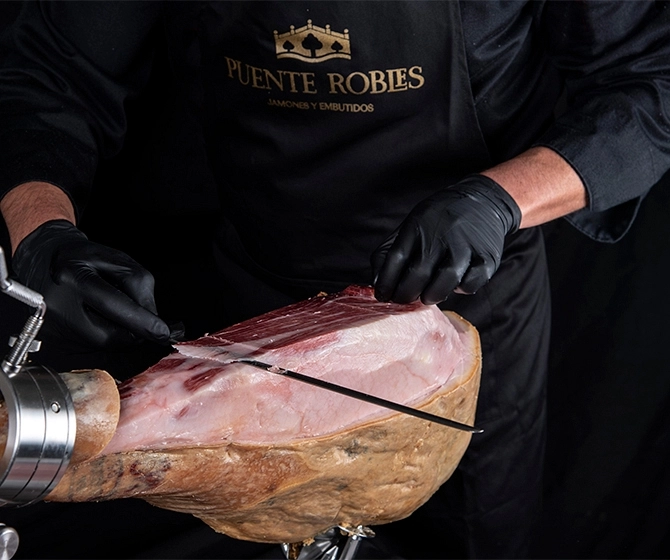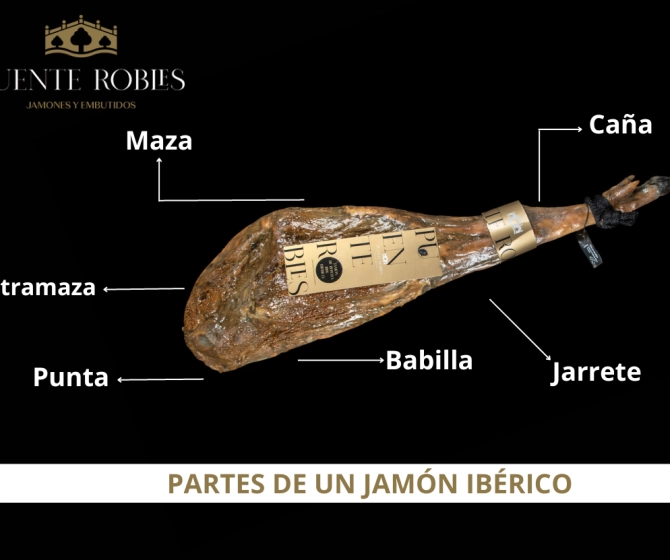How to cut an Iberian Ham? Step by Step Guide
When it comes to Spanish gastronomy, few things are as emblematic and delicious as a good Iberian ham.
Its unmistakable flavour and exquisite texture make it a culinary gem. However, to fully enjoy this delicacy, it is crucial to know how to cut it properly.
In this article, we will guide you step by step so that you can get the most out of your Iberian ham.
The Art of Cutting Iberian Ham
Iberian ham is a culinary jewel of Spain and Portugal, famous for its unparalleled flavour and delicate texture.
Slicing Iberian ham is not just a skill, it is an art that requires practice and patience.
The key to obtaining perfect slices is to know the anatomy of the ham and to use the right tools.
Moreover, by mastering this technique, you can fully appreciate the flavours and aromas that are released when slicing the ham just before eating it.
Necessary tools
Before you start slicing Iberian ham, you must make sure you have the right tools. Here are some of the essential tools you will need:
- Jamón Ibérico: Of course, you need a good quality Jamón Ibérico. Make sure it is from Puente Robles.
- Cuchillo Jamonero: This specialised knife has a long, thin blade designed to cut thin slices of ham. Its sharp edge is essential for a precise cut.
- Ham Board: A ham stand or ham board is a base that holds the ham in place while you slice it. This allows for greater stability and safety during the process.
This is just the essentials. From here you can equip yourself as much as you want, it depends on how professional you want to be.
Step 1: Preparation of the ham
Before you start slicing, you must prepare the ham properly. Follow these steps:
Place the ham on the ham stand with the hoof side up.
Remove the ham cover (bacon or rind) and save it to cover the ham when you are not slicing it. This ensures that the meat stays fresh and juicy.
Examine the ham to identify the fat and lean areas. Know all the parts of the Iberian ham:
Decide where you want to start slicing. There is no better or worse part to start with, it all depends on the rate at which the ham is going to be consumed.
If the consumption time is going to be longer than a week, we recommend starting with the stifle, the most cured part because it is narrower, leaving the thicker side of the mace, following the curing process until this part is finished. If we were to start cutting at the mace, when we start cutting the stifle after a few weeks, we would probably find it too cured.
If it is going to be consumed at events, which will be consumed practically on the same day, we will start to cut the ham from the "maza", the best part of the ham to obtain striking dishes.
Plan the time of consumption of your ham, and enjoy its parts accordingly.
Step 2: Cut Thin Slices
Thinly slicing ham is essential to appreciate its flavour and texture. Follow these steps:
With the ham knife in hand, make the first cut at the top of the shank, near the hoof. This cut is known as "punteo" and allows the ham to release its flavour.
Continue cutting thin slices at a downward angle, following the shape of the ham. Maintain a constant angle for even slices.
As you go along, you will notice that the meat becomes fattier and juicier. Adjust the pressure and angle of the cut as needed.
The ideal Iberian slice to balance the flavours and textures should be approximately 4 centimetres long, thin and at a temperature of between 18-20 degrees so that the fat melts on your palate, delighting you with the full flavour of an Iberian ham.
Step 3: Presentation and Enjoyment
Once you have cut the desired slices, it is time to present your masterpiece and enjoy the Iberian ham.
Place the slices on a plate or presentation board in a decorative manner.
If you have the bacon or rind of the ham, use it to cover the ham when you have finished slicing.
Iberian ham is best when served at room temperature. Allow the slices to rest for a few minutes before serving.
Accompany the ham with a good wine and perhaps some cheese and olives for a complete experience.
Conclusions
Slicing an Iberian ham may seem like a challenging task at first, but with practice and patience, you will become an expert.
The key is to use the right tools, know the anatomy of the ham and follow a precise technique. Once you have mastered this skill, you will be able to fully enjoy one of Spain's most prized gastronomic treasures. Bon appetit!
In our shop, we offer an exceptional selection of high quality Iberian hams, as well as cutting tools. Don't hesitate to visit us to find the perfect ham to practice your slicing skills and enjoy its incomparable flavour, we are waiting for you!



